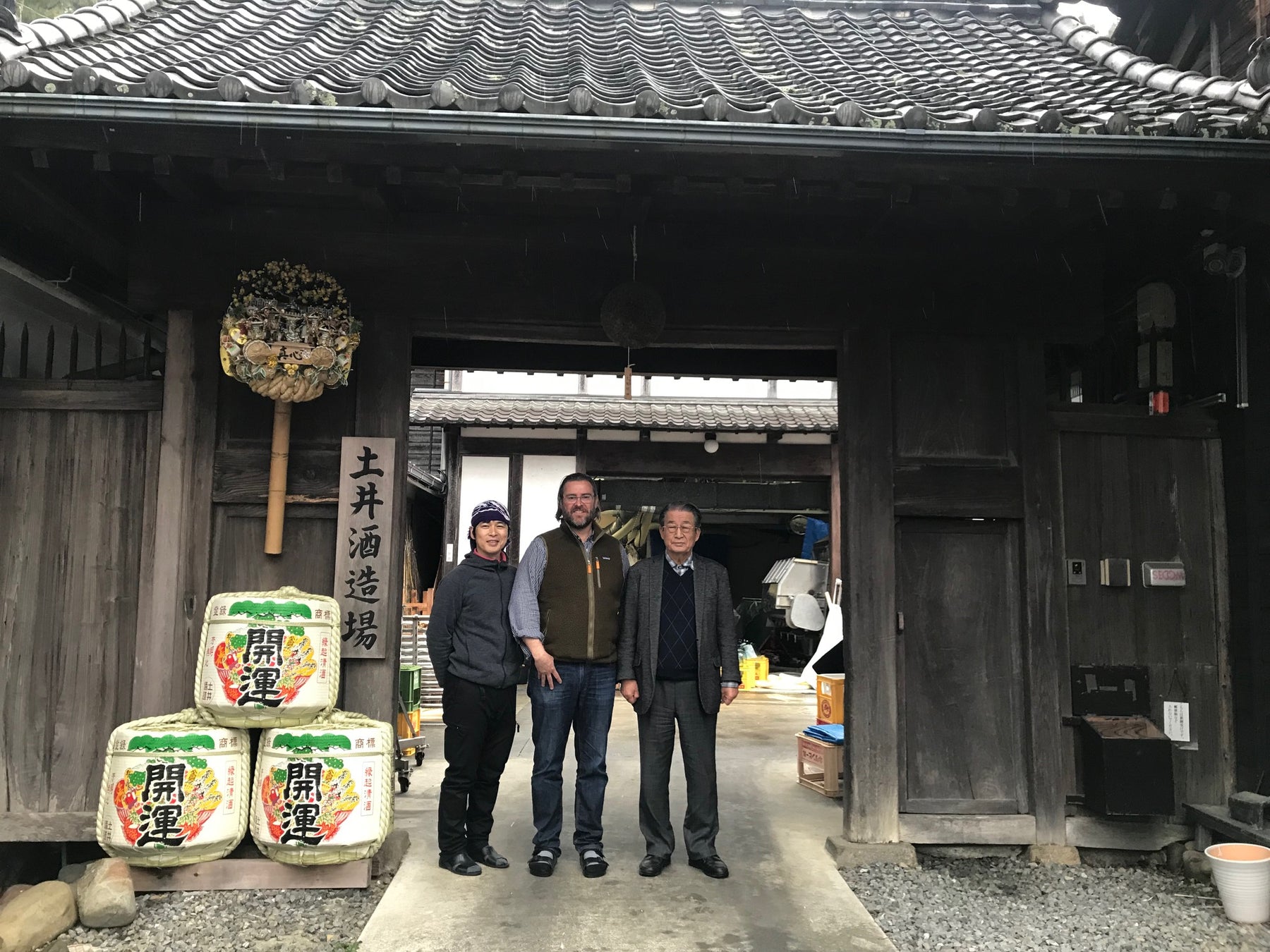
Sake Stories – A Quick Visit To Doi Shuzo In Shizuoka Prefecture
Last month, I visited a very small, but very cool brewery in Shizuoka on a rainy February afternoon. I was hoping for snow, but found out that it rarely, as in never, snows in that part of Japan. That was the first thing that blew me away. As well as what followed was for three hours of taking a sneak peak at a sake brewery that is almost all open air! Not kidding, as they do a large part of their brewing process outside. No way? Yes! Way!
 First off, how would you know this brewery? We’ve been selling their sake for well over a decade. You might know it as Kaiun! We’ve sold the celebration Junmai Ginjo for so long that I can’t remember when we added it to our inventory. They also have another brand, which gets imported by another importer, called Takatenjin or “Soul of The Sensei” which we just started carrying before I made the trip. Hmmmm? Is this curious timing? You bet! As I explained to the Doi family at their brewery I told them that it was impossible to carry every sake that is available to the American market. Sometimes I have to carry certain brews from certain importers to be fair, but I simply cannot carry them all. We try to be equitable to all of our importers. The result is that I carried Kaiun, but not Takatenjin.
First off, how would you know this brewery? We’ve been selling their sake for well over a decade. You might know it as Kaiun! We’ve sold the celebration Junmai Ginjo for so long that I can’t remember when we added it to our inventory. They also have another brand, which gets imported by another importer, called Takatenjin or “Soul of The Sensei” which we just started carrying before I made the trip. Hmmmm? Is this curious timing? You bet! As I explained to the Doi family at their brewery I told them that it was impossible to carry every sake that is available to the American market. Sometimes I have to carry certain brews from certain importers to be fair, but I simply cannot carry them all. We try to be equitable to all of our importers. The result is that I carried Kaiun, but not Takatenjin.
First off, the brewery is very small. And I love that. They brew about 90 tanks of sake each season. They have 8 sake employees, or “kurabito,” and they truck in their brewing water. It was actually sort of funny, because I have been to several breweries that also truck water to their kuras for production, but I had never asked the question, “Is water expensive?” As I found out, it is not expensive, and no they don’t need water contracts like rice growing contracts. The only real cost comes in the form of truck and fuel expenses, which add a little to the overall cost of making sake at Doi. But it is nominal. The brewery was founded it in 1868 and I learned quite a bit about what happened during the war, when they were forbidden to make sake. And I was told the story about how their family members almost gave up on brewing after the war, because nobody knew their brand or name. Thankfully they stuck with it. Today Doi Shuzo is widely regarded as an excellent brewery that wins many awards in Japan and abroad. And they have a cult following of sake fans.

Water in that region of the country is very soft and very pristine, which also helps the wasabi and green tea industries as well. They get most of their rice from Hyogo Prefecture, and they play around with certain yeasts that they buy and that they have cultivated. They do small batch brewing and they follow the template of their former head brewer who was a legend. Some cool highlights of the brewery include the use of solar power, and the fact they actually do a lot of work like washing and soaking the brewing rice outside. That sort of blew me away, but it does have to do with the warmer and less “snowy” weather. Doi uses an old-fashioned fune, or press, that squeezes out their super premium Daiginjo sake like many breweries, but they do something very odd and it was a first for me. They soak their rice bags in Daiginjo sake before pressing. Huh? Yup, they literally use Daiginjo sake in a bucket and soak the rice bags in that sake to safeguard against a bag taste! I love that!
 After the tour, we went into the office to taste some sake. I like that part a lot. The Doi’s poured several freshly pressed and unpasteurized brews including the ones we sell. This part of brewery tour visits is a little odd for me, because they look to me for approval of their sake making skills. They know that I am Co-Chairman of the IWC, and they also know that I was very impressed with their Ginjo sake that won the Ginjo trophy at IWC’17! So I have to be on point! And I have to give them as much info and impressions about their sake in a short period of time. It’s as if I am being judged (watched) as I “judge” their sake. It’s a little weird! But hey! I am not complaining. And guess what? I tasted great sake! Oh, and I also discovered that after they won the Trophy for the best Ginjo on the market, they sold out that season. And then doubled production the next season, and sold that out too. And yes, they planned to keep doubling production this year!
After the tour, we went into the office to taste some sake. I like that part a lot. The Doi’s poured several freshly pressed and unpasteurized brews including the ones we sell. This part of brewery tour visits is a little odd for me, because they look to me for approval of their sake making skills. They know that I am Co-Chairman of the IWC, and they also know that I was very impressed with their Ginjo sake that won the Ginjo trophy at IWC’17! So I have to be on point! And I have to give them as much info and impressions about their sake in a short period of time. It’s as if I am being judged (watched) as I “judge” their sake. It’s a little weird! But hey! I am not complaining. And guess what? I tasted great sake! Oh, and I also discovered that after they won the Trophy for the best Ginjo on the market, they sold out that season. And then doubled production the next season, and sold that out too. And yes, they planned to keep doubling production this year!
 Before we left, the brewery’s current president’s mother came out from behind a sliding door with a photo album. She showed us pictures from her visit to True Sake 12 years ago. It blew me away. It made me feel pretty cool too. I remember the visit, but the memory is pretty foggy. She said that the visit changed her impression of how well sake would do overseas, and inspired them to export more nihonshu to the west. Woot! That made me smile.
Before we left, the brewery’s current president’s mother came out from behind a sliding door with a photo album. She showed us pictures from her visit to True Sake 12 years ago. It blew me away. It made me feel pretty cool too. I remember the visit, but the memory is pretty foggy. She said that the visit changed her impression of how well sake would do overseas, and inspired them to export more nihonshu to the west. Woot! That made me smile.
They are also very emphatic about cleaning the water that they use in their production. Doi Shuzo has their own water-treatment facility that they are very proud of and showed us how it works. Basically, they feel that it is their “responsibility” to clean their wastewater before returning it to the city waste water supply. At first, I couldn’t tell what the large water-treatment structure was, especially since the water looked brown and frothy like the chocolate river in the Willy Wonka movie. Yes people, I am slow! But with that and their solar power efforts it speaks to a brewery that cares about their environment and that’s pretty cool.
As we were preparing to leave her son, who is now the president and runs the show, asked me what bottle would I like to take with me? Really? Yes! So I selected an Omachi nama that was superb. He said great and ran off to get the sake. When he returned, as we were getting into the cab, in the rain he handed me an ishobin in a bag! What? I didn’t know that the Nama Omachi only came in a 1.8L bottle so I felt like a greedy sake pig, but he laughed and said it was okay! And yes that Omachi nama was okay for the next three nights in Japan!
And you would all be very proud of me, because as much as I wanted to make the Homer Simpson “D’oh!” sound during my visit to Doi Shuzo I held off. Now that is called control folks!
